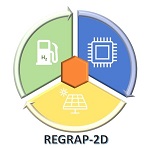Resumen del proyecto coordinado:
El Plan Nacional Integrado de Energía y Clima (PNIEC) establece los objetivos de reducción de emisiones de gases de efecto invernadero, de implantación de las energías renovables y de eficiencia energética para el 2030. Para lograrlos es necesario crear dispositivos eficientes con nuevos materiales avanzados que permitan generar y almacenar energía de manera segura, sostenible y limpia.
Últimamente, los materiales bidimensionales han generado un enorme interés debido a sus excepcionales propiedades. En concreto, el grafeno fue el protagonista en la iniciativa para Tecnologías Emergentes y Futuras (Graphene Flagship) creada en 2013 por la Unión Europea, para abordar los nuevos retos científicos y tecnológicos que este material plantea. Este interés se ha extendido a otros materiales bidimensionales (2D) con aplicaciones muy prometedoras.
El proyecto REGRAP-2D tiene como finalidad el desarrollo de materiales 2D, grafénicos y no grafénicos, así como materiales basados en grafeno 3D, y su incorporación en diversos dispositivos:
- Dispositivos de generación de energía. En células solares de heterounión de silicio y de tipo Schottky.
- Dispositivos de almacenamiento de energía eléctrica. En concreto en supercondensadores de doble capa, implementando materiales grafénicos funcionalizados tanto 2D como 3D en sus electrodos,
- Dispositivos para la investigación del almacenamiento de hidrógeno con materiales 3D basados en grafeno.
Además el proyecto incorpora el desarrollo de una interfaz electrónica que permitirá integrar el generador de energía (célula solar) y el almacén de energía (supercondensador) en un único dispositivo, con la máxima eficiencia. En este sentido, se pretende cubrir todos los aspectos, desde la generación de energía de origen renovable hasta su almacenamiento y explotación.
Este proyecto propone que en el Centro de Investigaciones Energéticas, Medioambientales y Tecnológicas (CIEMAT) se diseñe y fabrique las nuevas células solares y el dispositivo de almacenamiento de hidrógeno y realice la integración de las células solares con los supercondensadores, mientras que el Instituto de Sistemas Optoelectrónicos y Microtecnologías (ISOM), de la Universidad Politécnica de Madrid, se encargue del crecimiento del grafeno mediante la deposición química en fase vapor (CVD), de la transferencia de este grafeno y la de otros materiales 2D a las células solares y de la fabricación de los supercondensadores con estos materiales.
La complejidad del proyecto obliga a la participación de distintos grupos con especialidades distintas que colaboran para conseguir los objetivos propuestos.
Los objetivos de este proyecto se encuentran claramente integrados en el PNIEC y en el Programa Estatal I+D+i Orientada a los Retos de la Sociedad y en las pautas para la Transición Energética Ecológica, así como en reciente Borrador de la Estrategia de Almacenamiento Energético, a nivel nacional. A nivel europeo forman parte del Pacto Verde Europeo para alcanzar una economía sostenible, del Paquete de Energía Limpia para Todos y de la Alianza Europea para la Investigación en Energía, en varios aspectos entre los que destacan la Energía Solar Fotovoltaica, el Almacenamiento de Energía y la Integración de Sistemas Energéticos. También se encuentran en los recientes documentos A Hydrogen Strategy for a climate-neutral Europe y en el Joint Undertaking of Fuel Cells and Hydrogen.
